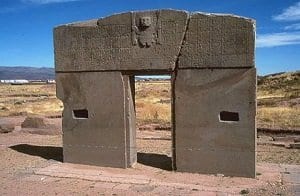#3 Tiwanaku´s culture
Our Spanish school in Bilbao welcomes you back into the Hispanic culture because learning Spanish is not only lectures, but also knowledge of its history and legacy. Today we moved at the time of the Tiwanaku culture. This Andean culture is considered by many historians as the oldest pre-Hispanic cultures.
It developed between 1500 to. C and 1200 d. C in territories of the current countries of Perú, Bolivia, northern Chile and northwestern Argentina, dividing his chronology into three periods: village or archaic period (1500 C-45 d C), urban or classical period (45-700 d. C) and imperial or expansive period (700-1200 d. C). Its capital, Tiwanaku, is located 70 km from La Paz (Bolivia) and 15 km from Lake Titicaca.
When the Spanish conquerors discovered the ruins of this city in the sixteenth century, they were amazed at such architectural structures.
The conqueror, but foremost historian and chronicler Pedro Cieza de Leon, in the first part of his Chronicle of Peru (1553), which recounts the description of the territory and its inhabitants, mentioned decorations and structures of Tiwanaku city.
The Semi-subterranean little temple (belonging to the urban or classical period) is a rectangular structure whose walls are adorned by 175 embedded heads (scholars think these sculptures refer to the various peoples who were part of Tiwanaku).
Anthropomorphic pieces like the “bearded monolith” or Kontiki and a figure of more than 7 meters high called “monolith Bennett” (referring to its discoverer Wendell Bennett) or Pachamama were found on the inside. The Kantatallita or “Light of Dawn” is a rectangular structure where it is found the so called “piedra maqueta” which shows excellent iconographic work. The Akapana is a pyramid of 15 meters high made up of seven platforms.
From its height two holy places revered by the Tiwanaku can be seen: to the East the Illimani mountain and to the West the Lake Titicaca.
Remains of sacrifices (including humans) were found at the foot of the pyramid, made for the consecration of the building. The Kalasasaya (“Piedra Parada” in Aymara language) is a solar temple that houses inside the “monolith Ponce” (in which right shoulder appeared an engraved cross, sign that it was known by the Spanish colonizers, although it was not found until 1964) and the “Fraile” or “God of Water”. But the most representative piece of this city is precisely in this temple and is called Puerta del Sol.
The central figure represents Tunupa, primeval Andean god, Lord of air and geotectonic phenomena, later to be replaced by Viracocha, the creator god of the Incas.
Putuni or “Palace of the sarcophagi” has a rectangular ground plan and it contains the burial tombs of the Tiwanaku lords. Finally, 2 kilometers from Tiwanaku, is located the ceremonial center of Puma Punku (Gate of the Puma) with a pyramidal structure built in the late urban or classical period.
The decline of this civilization occurred, among other factors, by climatic changes that occurred around the middle of X century AD. C. Massive droughts caused the shortage of crops and the disappearance of farmlands. The city of Tiwanaku was abandoned and the population spread to villages and smaller settlements, while at the same time pastoral peoples from southwest Bolivia began arriving in the area of Lake Titicaca.
Over time these human groups moved to higher altitudes and in fortified places now called “Señoríos aimaras”. The importance of this culture lies in its subsequent influence on other cultures in the region, due to their advanced knowledge and their success achieved thanks to a perfect political and administrative organization.
If you liked this brief historical note about the Tiwanaku culture, here in LINCE Spanish School we we invite you to keep on enjoying these interesting stories on our Spanish school’s blog. See you soon!


